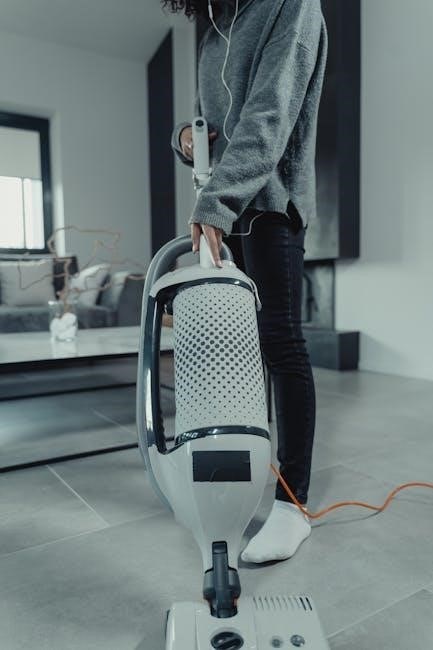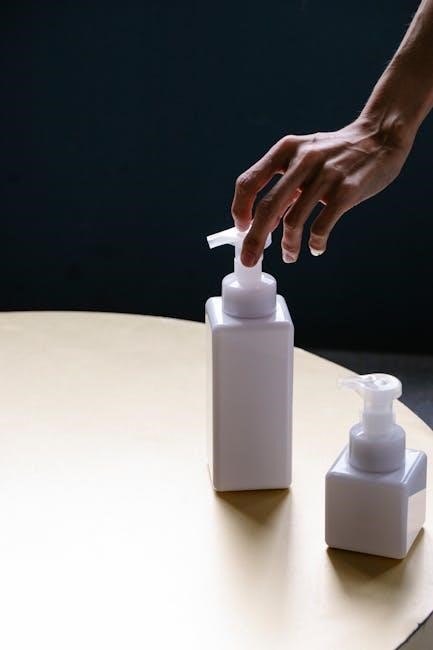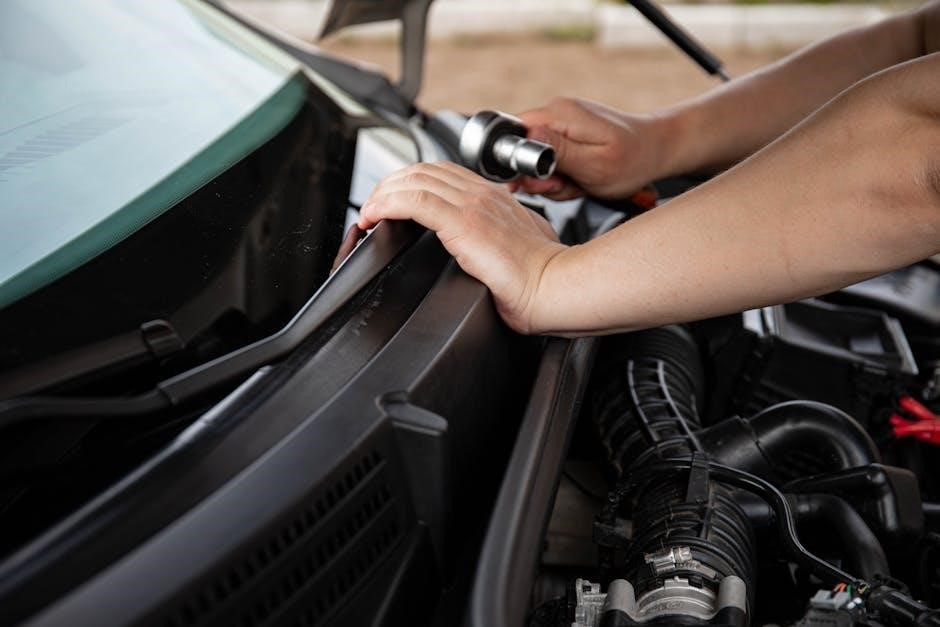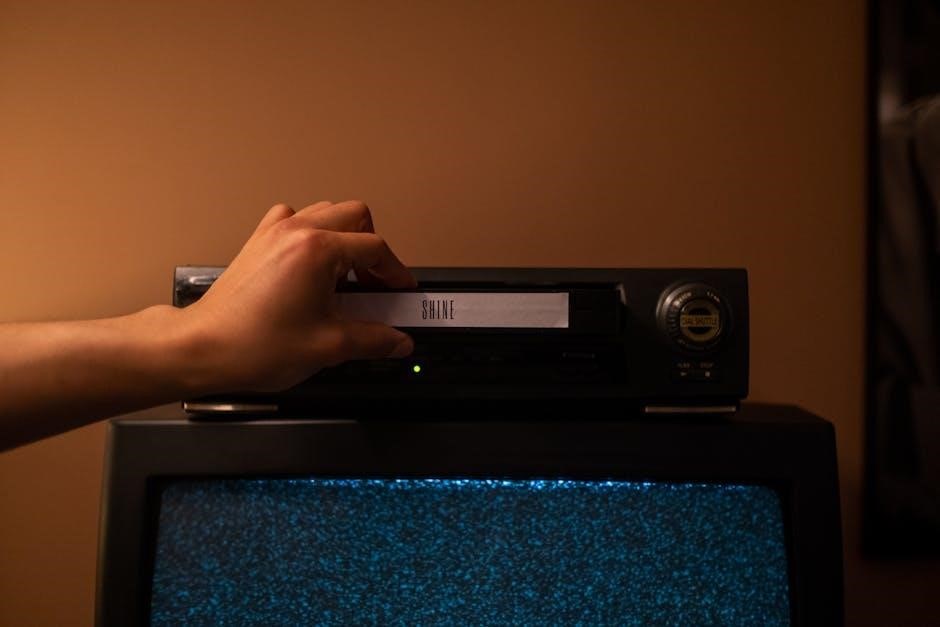hoover vacuum manuals
Welcome to our guide on Hoover vacuum manuals. Explore comprehensive instructions for optimal performance, easy troubleshooting, and maintenance of your Hoover vacuum cleaner effectively.
Overview of Hoover Vacuum Cleaner Models
Hoover offers a diverse range of vacuum cleaner models, from cordless stick vacuums to upright and canister cleaners. Popular models include the Hoover H-Free 100, known for its portability, and the Power Scrub Elite FH50250, designed for deep carpet cleaning. The ONEPWR Cordless Series provides versatile, cord-free cleaning solutions. Each model is tailored to specific cleaning needs, ensuring efficiency and ease of use. Whether for hard floors, carpets, or pet hair, Hoover vacuums are built with innovative features to enhance cleaning experiences.
Importance of Using Official Hoover Manuals
Official Hoover manuals are essential for maximizing your vacuum’s performance and longevity. They provide clear instructions for assembly, operation, and maintenance, ensuring safe and effective use. These guides help users troubleshoot common issues, reducing the risk of damage. Additionally, official manuals offer warranty compliance and access to detailed diagrams, making repairs easier. By following the manual, users can optimize their cleaning experience and extend the life of their Hoover vacuum cleaner. Always refer to the official manual for accurate and reliable guidance.
Popular Hoover Vacuum Models and Their Manuals
Discover top Hoover models like the H-Free 100, Power Scrub Elite, and ONEPWR series, each with detailed manuals available for easy download and reference online.
Hoover H-Free 100: Features and Manual Highlights
The Hoover H-Free 100 is a popular cordless vacuum known for its lightweight design and versatile cleaning capabilities. Its manual provides detailed instructions on assembly, operation, and maintenance. Key features include multiple suction modes, detachable batteries, and a range of attachments for various surfaces. The manual also covers troubleshooting common issues and offers tips for optimizing performance. Available in PDF format, the H-Free 100 manual ensures users can easily access and reference guidance online, making it a valuable resource for mastering this efficient cordless vacuum cleaner.

Hoover Power Scrub Elite FH50250: Detailed Manual Guide
The Hoover Power Scrub Elite FH50250 is a powerful carpet washer designed for deep cleaning. Its manual provides in-depth instructions for assembly, operation, and maintenance. Key features include multiple cleaning modes, a robust brush system, and a large tank capacity. The guide also covers troubleshooting common issues and offers tips for optimal performance. Available in PDF format, the FH50250 manual ensures users can easily access and reference detailed information, making it an essential resource for maximizing the cleaner’s efficiency and extending its lifespan.
Hoover ONEPWR Cordless Vacuum Series: Manual Insights
The Hoover ONEPWR Cordless Vacuum Series offers a range of cordless cleaning solutions. Its manual provides insights into assembly, charging, and operation. Key features include interchangeable batteries, lightweight designs, and advanced suction power. The guide also covers maintenance tips, such as cleaning filters and checking for blockages. Available online in PDF format, the manual ensures easy access to troubleshooting and care instructions, helping users maintain peak performance and extend the life of their ONEPWR cordless vacuum for efficient cleaning experiences.

How to Download and Access Hoover Manuals
Visit the official Hoover website, search by model number, and download PDF manuals for free. Easy access ensures quick troubleshooting and maintenance guidance anytime.
Step-by-Step Guide to Finding Your Hoover Manual Online
To find your Hoover manual online, visit the official Hoover website and navigate to the “Support” or “Manuals” section. Enter your vacuum’s model number in the search bar. Select your specific model from the results to access the PDF manual. If unavailable, check third-party sites like Manua.ls, which hosts over 1,000 Hoover manuals. Ensure the manual matches your model for accurate instructions. Download the PDF for offline access and refer to it for troubleshooting, assembly, and maintenance guidance.
PDF Format: Benefits and How to View Hoover Manuals

Hoover manuals are often available in PDF format, offering easy access and portability. This format ensures universal compatibility across devices and retains the document’s layout and graphics. To view a PDF manual, download it from Hoover’s official website or trusted sources like Manua.ls. Use a PDF reader such as Adobe Acrobat or Foxit Reader. Once downloaded, you can zoom in for detail, search for specific keywords, and print sections as needed. PDF manuals are eco-friendly and convenient, providing instant access to troubleshooting, assembly, and maintenance instructions for your Hoover vacuum cleaner.
Key Components of Hoover Vacuum Manuals
Hoover manuals include detailed assembly instructions, maintenance tips, troubleshooting guides, and safety precautions to ensure optimal performance and longevity of your vacuum cleaner.
Assembly and Initial Setup Instructions
Hoover vacuum manuals provide clear assembly and setup steps, ensuring a smooth start. Unpack and identify components like the dust bin, filters, and additional attachments. Follow the guide to securely attach handles, wheels, or other modular parts. For cordless models, charge the battery as instructed before first use. Refer to diagrams for proper assembly of accessories like crevice tools or upholstery brushes. Double-check all connections for stability and ensure moving parts operate freely. Proper assembly is crucial for optimal performance and longevity of your Hoover vacuum cleaner.
Operating and Maintenance Guidelines

Hoover vacuum manuals outline essential operating and maintenance tips to ensure longevity and efficiency. Regularly clean or replace filters to maintain suction power and prevent dust buildup. Empty the dust bin after each use to avoid reduced performance. Check for blockages in hoses or brush rolls and clear them promptly. For optimal results, use the correct settings for different floor types. Store your vacuum in a dry, cool place to protect electrical components. Refer to your manual for model-specific maintenance schedules and troubleshooting advice to keep your Hoover vacuum performing at its best.

Troubleshooting Common Issues
Hooover vacuum manuals provide detailed troubleshooting guides for common issues like reduced suction, unusual noises, or malfunctioning parts. If your vacuum loses suction, check for blockages in the hose or filter and ensure the dust bin is empty. For noisy operation, inspect the brush roll for tangled debris or damaged belts; If the vacuum overheats, turn it off and let it cool before restarting. Refer to your manual for step-by-step solutions and diagrams to address specific problems effectively, ensuring your Hoover vacuum operates smoothly and efficiently.

Hoover Vacuum Accessories and Attachments
Hooover vacuums come with versatile accessories like crevice tools, upholstery brushes, and extension wands. These enhance cleaning efficiency for various surfaces, ensuring a thorough cleaning experience always.
Understanding Additional Parts and Their Usage
Hoover vacuum cleaners often come with additional parts designed to enhance cleaning efficiency. These include crevice tools for tight spaces, upholstery brushes for furniture, and extension wands for reaching high areas. Motorized brushes are ideal for deep carpet cleaning, while dusting brushes are perfect for surfaces like blinds or shelves. Understanding these accessories ensures you use your vacuum to its full potential, adapting to various cleaning tasks. Proper usage of these parts, as outlined in the manual, helps maintain your vacuum’s performance and extends its lifespan.
Optional Accessories for Enhanced Cleaning

Optional accessories for Hoover vacuums include specialized brushes, crevice tools, and extension wands, designed to tackle specific cleaning tasks. Motorized brushes enhance carpet cleaning, while upholstery brushes are ideal for furniture. Additional filters and dust bags improve performance. These accessories, detailed in the manual, allow for tailored cleaning solutions. They provide versatility and efficiency, ensuring your Hoover vacuum adapts to various surfaces and spaces. Exploring these options maximizes your cleaning potential and enhances overall satisfaction with your appliance.

Hoover Customer Support and Service Centers
Hoover offers dedicated customer support and service centers to assist with inquiries, repairs, and maintenance. These resources ensure optimal performance and longevity of your Hoover vacuum cleaner.
How to Contact Hoover for Manual-Related Queries

For assistance with Hoover vacuum manuals, visit their official website and navigate to the “Contact Us” or “Support” section. Here, you can find phone numbers, email addresses, or contact forms. Calling their customer service number is another direct method. Additionally, many companies offer email support, allowing you to send your inquiry and receive a detailed response. Some may also provide live chat options on their website for immediate help. Checking the manual itself might provide contact information. Visiting a local service center or reaching out through social media platforms like Twitter or Facebook can also be effective. Finally, contacting the retailer where you purchased the vacuum might offer further assistance or direct you to the appropriate support channel.
Service Centers: Repair and Maintenance Options
Hoover operates a network of authorized service centers for repair and maintenance of their vacuum cleaners. These centers are equipped with certified technicians who use genuine parts to ensure optimal performance. Regular maintenance at these centers can extend the life of your vacuum and prevent potential issues. Users can locate their nearest service center through the official Hoover website or by contacting customer support. Additionally, these centers offer repair services for models under warranty, providing a reliable solution for any malfunction. Visiting an authorized service center ensures your Hoover vacuum receives expert care, maintaining its efficiency and longevity.


































































